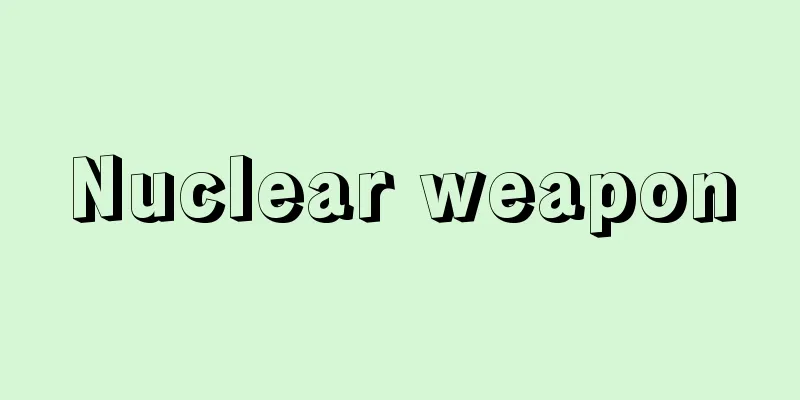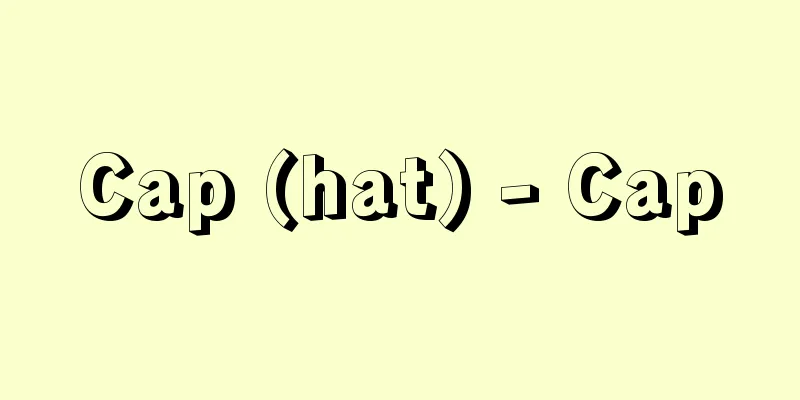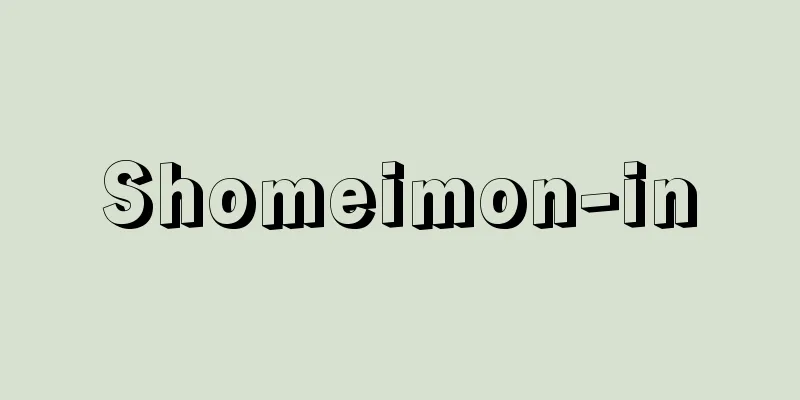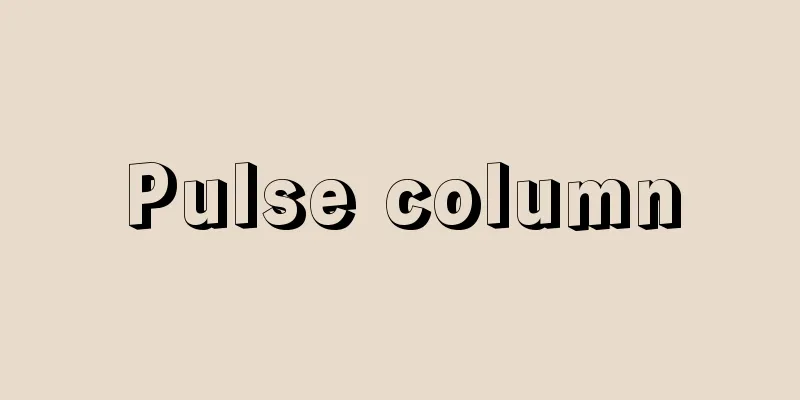Nuclear weapon

|
A weapon that uses an explosive release of energy through nuclear reactions such as nuclear fission and nuclear fusion to cause mass destruction or death. Types of nuclear weaponsThe world's first nuclear weapon was a fission weapon that was completed in July 1945 (Showa 20) and dropped on Hiroshima on August 6th and Nagasaki on the 9th, destroying both cities. The term "atomic bomb" was used in an announcement by U.S. President Truman, and the name stuck. Later, hydrogen bombs, which utilize nuclear fusion reactions, were created. When atomic bombs were first completed, each bomb weighed more than four tons. Since then, the technology for delivery has improved, while nuclear weapons have become smaller and lighter, leading to the development of various nuclear weapon systems. Meanwhile, various tactical nuclear weapons have been developed, primarily for use on the battlefield. There are various ways to distinguish between strategic and tactical nuclear weapons, but strategic weapons are those capable of directly attacking the enemy's center, while tactical weapons are those used on the battlefield. Strategic and tactical nuclear weapons are primarily distinguished by their range. In arms control and disarmament negotiations between the United States and the Soviet Union, strategic nuclear weapons are defined as ballistic missiles with a range capable of directly attacking the other country, i.e., a range of more than 5,500 kilometers, the shortest distance between the two countries. As a system for carrying strategic nuclear warheads, [Manabu Hattori and Tomohide Murai] Principles and Structure of the Atomic BombThe atomic nuclei of uranium-235, plutonium-239, and uranium-233 are called fissile materials because they have the property of easily undergoing nuclear fission reactions when they absorb neutrons. If a certain amount of fissile material, called a critical amount, is gathered in one place, a chain reaction of nuclear fission will occur. In the case of an atomic bomb, the fissile material is divided into several parts below the critical amount, which are then rapidly combined to create a supercritical state, releasing a large amount of energy in a short period of time and causing a nuclear explosion. The atomic bomb dropped on Hiroshima was a gun-barrel type, in which about 60 kilograms of uranium-235 was split into two and one was fired at the other with explosives. The efficiency was very low, with only about 1% causing a nuclear fission chain reaction, but it still had the power of about 15 kilotons (equivalent to 15,000 tons of trinitrotoluene gunpowder). The one dropped on Nagasaki used an implosion method in which about 8 kilograms of plutonium-239 was placed in a hollow sphere and compressed to a supercritical state by an inward spherical wave generated when explosives were detonated on the outside of the sphere, which was more efficient and had a yield of about 22 kilotons. It is currently believed that about 15 kilograms of uranium-235 or about 4 kilograms of plutonium-239 are needed to make one fission weapon. [Manabu Hattori and Tomohide Murai] Principle and structure of hydrogen bombHydrogen bombs use the energy released by the nuclear fusion reaction (also called a thermonuclear reaction) of light atomic nuclei such as deuterium and tritium, which are isotopes of hydrogen. A high temperature of over several million degrees Celsius is generally required to cause a nuclear fusion reaction. Currently, the high temperature generated by the explosion of an atomic bomb is used to trigger the nuclear fusion reaction in a hydrogen bomb. In reality, the energy generated by the explosion of an atomic bomb is transmitted in the form of X-rays to the surrounding area of the adjacent fusion material, compressing it and creating the extremely high temperature that causes the nuclear fusion reaction. [Hattori Manabu] Neutron bombs and other nuclear weaponsNuclear fusion reactions produce a large amount of neutrons. These neutrons can also cause further nuclear fission reactions. The ratio of the explosive energy of a hydrogen bomb that comes from nuclear fission reactions and nuclear fusion reactions can be varied in various ways. A 3F bomb is a bomb that has been made more powerful through a three-stage reaction of nuclear fission, nuclear fusion, and nuclear fission. However, since it produces a large amount of residual radioactive products called "fallout" from nuclear fission, it is also known as a "dirty hydrogen bomb." It was this type that was tested by the United States at Bikini Atoll on March 1, 1954. If the initial nuclear fission is kept as low as possible, the power and amount of residual radioactivity are kept small, and the rate of nuclear fusion is increased, a large amount of neutrons will be generated in an instant. This is what is called a neutron bomb, which is intended to kill people. On the other hand, if these neutrons are used to create a large amount of radioactive material, this is called a radioactive weapon. [Hattori Manabu] Kiloton, MegatonThe power of a nuclear explosion is measured in kilotons (1,000 tons) or megatons (1 million tons) of TNT (trinitrotoluene) explosive. The powers of the Hiroshima and Nagasaki atomic bombs are estimated to be 15 and 22 kilotons of TNT, respectively. The American hydrogen bomb test at Bikini Atoll in March 1954 had a power of about 15 megatons of TNT. The largest nuclear explosion to date was the Soviet test of an estimated 56 megaton hydrogen bomb in 1961. Neutron bombs are said to have a power of less than 1 kiloton. [Manabu Hattori and Tomohide Murai] Nuclear explosion effectsIn a nuclear explosion, the amount of energy generated per unit weight is large, so a fireball with a temperature of several million degrees Celsius is produced, and a large proportion of the energy is released as heat rays. Another portion of the energy appears as radiation. In the case of an atomic bomb exploding in the air, the energy is distributed as follows: about 50% in blast and shock waves, about 35% in heat rays, and about 15% in radiation. One-third of the radiation is released within about one minute after the explosion, known as initial radiation. The remaining two-thirds is released over a long period of time as residual radiation. With hydrogen and neutron bombs, the proportion of radiation, especially initial radiation, is much greater. The Hiroshima atomic bomb exploded at a height of about 580 meters above the center of the flat city, but the destruction of buildings caused by the blast and fires caused by heat rays devastated about 13 square kilometers of the city. By December 1945, about 140,000 people had died, of which about 20% died from injuries caused by the blast, about 60% from burns, and the remaining 20% from radiation damage. In the case of Nagasaki, the explosion occurred about 500 meters above the mountains away from the center of the city, so the power was greater than that of the Hiroshima atomic bomb, but the damage was slightly less. The radioactive material that had turned into gas in the fireball of the explosion gradually condenses and falls to the ground, adhering to soil, other particles, or water droplets. This is called radioactive fallout. In addition, the explosion of a nuclear weapon generates a strong electromagnetic wave called an electromagnetic pulse (EMP), which has the effect of destroying electronic circuits, etc. [Manabu Hattori and Tomohide Murai] The development of nuclear weaponsIn December 1938, German chemists Otto Hahn (1879-1968) and Friedrich W. Strassmann (1902-1980) discovered the phenomenon of nuclear fission of uranium nuclei. They realized that if a chain reaction of nuclear fission could be induced, it would be possible to extract a large amount of energy. In the United States, Hungarian physicist Leo Szilard (1898-1964) was concerned that research into the manufacture of an atomic bomb was progressing in Germany, and in July 1939, he had Einstein write a letter to President F. D. Roosevelt to draw his attention to the matter. Scientists around the world considered using uranium as a power source rather than relying on an instantaneous chain reaction like a bomb, but in March 1940, Otto Frisch (1904-1979) and Rudolf Peierls (1907-1995) of Britain realized that it would be possible to build an atomic bomb if only uranium-235 could be enriched. They submitted a memorandum to the British government, which was also shared with the United States. In August 1942, the United States began a project to build an atomic bomb, called the Manhattan Project, and over the course of three years, a colossal 2 billion dollars was spent. On July 16, 1945, the world's first atomic bomb was exploded in the desert of Alamogordo, New Mexico. On August 6, 1945 (Showa 20), atomic bombs were dropped on Hiroshima, and on August 9, on Nagasaki, shortly after which World War II came to an end. In August 1949, the Soviet Union also conducted an atomic bomb test. In response, the United States began developing a hydrogen bomb. On March 1, 1954, a full-scale hydrogen bomb test was conducted at Bikini Atoll in the Pacific Ocean. The following year, in 1955, the Soviet Union also succeeded in conducting a full-scale hydrogen bomb test. Thus began the nuclear arms race centered on the United States and the Soviet Union. Other countries besides the United States and the Soviet Union include the United Kingdom, which conducted an atomic bomb test in October 1952 and a hydrogen bomb test in May 1957. France conducted an atomic bomb test in February 1960 and a hydrogen bomb test in August 1968. China conducted an atomic bomb test in October 1964 and a hydrogen bomb test in June 1967. India also conducted an underground nuclear test in May 1974, and an underground nuclear test of an atomic bomb and a hydrogen bomb in May 1998. In response, Pakistan also conducted an atomic bomb nuclear test. It is also believed that Israel already possesses nuclear weapons. South Africa claims to have built nuclear weapons but later destroyed them. North Korea announced successful nuclear tests in October 2006 and May 2009. Meanwhile, in August 1963, the United States, the United Kingdom and the Soviet Union signed the Partial Nuclear-Test-Ban Treaty, which banned nuclear weapons testing in the atmosphere, outer space and underwater, but did not ban underground nuclear testing. In the 1950s and early 1960s, the competition was mainly in terms of quantity, with the number and power of nuclear weapons increasing. From the late 1960s to the 1970s, the competition became one of quality. In particular, the development of submarine-launched ballistic missiles brought about mutual assured destruction (MAD) between the United States and the Soviet Union, whereby even if one side attacked and destroyed the enemy first, the enemy's submarine would survive and a retaliatory attack from the submarine would destroy the first attacker, stabilizing the Cold War. [Manabu Hattori and Tomohide Murai] The current state of nuclear weapons and the threat of nuclear warIn 1968, Secretary-General U Thant published the White Paper on Nuclear Weapons, and in September 1980 Secretary-General Waldheim published a report entitled Comprehensive Study of Nuclear Weapons. The contents covered a wide range of topics, including the actual state of nuclear weapons, trends in the technological development of nuclear weapons, the effects of using nuclear weapons, theories on nuclear weapons such as deterrence theory, and treaties on nuclear disarmament. According to this report, there were 40,000 to 50,000 nuclear warheads in stock worldwide, with a combined power equivalent to about one million Hiroshima-type atomic bombs, and the majority of these were held by the United States and the Soviet Union. Of these, it was estimated that the United States had 9,200 strategic nuclear warheads and the Soviet Union had 6,000. The final document of the First Special Session of the United Nations General Assembly on Disarmament held in 1978 stated that "nuclear weapons pose the greatest danger to the survival of mankind and civilization." Although there are concepts such as a limited nuclear war, which would limit the power, type, number, target, and area of use of nuclear weapons, the damage would be unimaginable if dozens or even hundreds of nuclear weapons were used. Moreover, once nuclear weapons are used, there is a much greater possibility of escalating into an all-out nuclear war. [Manabu Hattori and Tomohide Murai] Nuclear Weapons RegulationThe issue of nuclear weapons regulation was not anticipated during wartime when the United Nations Charter was drafted, as the first nuclear weapon was completed in July 1945 in the United States. Nuclear weapons were used in Hiroshima and Nagasaki in Japan in the final stages of World War II, causing a great shock, and discussions on the issue began at the United Nations immediately after the war. The United States, the only nuclear power at the time, submitted a proposal for international control of atomic energy (the so-called Baruch Plan). Considering the extraordinary destructive power of nuclear weapons, this was based on the idea that free nuclear activities in each country could no longer be left unchecked, but politically, it also had a strong aim to prevent the Soviet Union from developing nuclear weapons, which it was rushing to do at the time. In response, the Soviet Union submitted a proposal to ban atomic weapons, but this was a prohibition proposal that was premised on the destruction of nuclear weapons already possessed by the United States. The discussions between the United States and the Soviet Union did not mesh, and no results were achieved in the 1940s and 1950s. A concrete agreement was not established until 1963 under the "U.S.-Soviet system" based on mutual nuclear deterrence between the United States and the Soviet Union. On the one hand, nuclear weapons are weapons that are humanely unacceptable due to their extraordinary destructive power and cruelty. On the other hand, major powers use the resulting restraint and caution in their security policies. The regulation of nuclear weapons has become a search for a balance between these two aspects. Since then, many regulatory agreements were made during the so-called detente period of the 1960s and 1970s, the end of the Cold War from the late 1980s, and after the Cold War. In terms of the types of regulations, there are the following: (1) the balance of nuclear forces management between the United States and the Soviet Union (Russia), (2) indirect nuclear weapons regulations that limit nuclear testing and prevent the increase in nuclear-weapon states, (3) agreements that limit the role of nuclear weapons in terms of purpose of use and geography by establishing spaces where the deployment of nuclear weapons is prohibited or by non-nuclear weapon states establishing nuclear-weapon-free zones, and (4) treaties that ban nuclear weapons themselves. [Masatsugu Noie July 19, 2019] US-Soviet (Russian) Arms Race ManagementThe first agreements were born out of the Strategic Arms Limitation Talks (SALT) between the US and the Soviet Union, which began in 1969. One was the ABM (Anti-Ballistic Missile) Treaty (signed in 1972), and the other was the Strategic Arms Limitation Agreement I (SALT-I, signed in 1972, expired in 1997). The full-scale SALT-II treaty, which succeeded the SALT-I agreement, was signed in 1979, but did not come into force due to the tensions of the "New Cold War" that began in the late 1970s. The 1970s agreement set loose limits on offensive weapons such as ICBMs, while banning defensive weapons such as ABMs in principle, thereby maintaining a mutually vulnerable state, i.e., "if one attacks, the other will inevitably suffer a major blow in retaliation," thus stabilizing a state in which neither side could launch a first attack (a mutually assured destruction regime), which became the basis of the US-Soviet system until the end of the Cold War. Towards the end of the Cold War, this line of negotiations resulted in the Intermediate-Range Nuclear Forces (INF) Treaty (signed in 1987, entered into force in 1988). This treaty stipulated the total elimination of ground-launched intermediate-range nuclear missiles worldwide, and was the first to include detailed verification provisions, including on-site inspections, symbolizing the easing of East-West conflict. The first Strategic Arms Reduction Treaty (START-I, signed in 1991, entered into force in 1994), which progressed from "limiting" strategic weapons to "reducing" them, roughly halved the strategic nuclear forces of both the United States and the Soviet Union to 1,600 delivery vehicles and 6,000 warheads, marking the end of the Cold War. The second Strategic Arms Reduction Treaty (START-II) was signed in 1993, which stipulated a further halving of strategic nuclear warheads to 3,000-3,500. However, in order to deal with the threat of nuclear proliferation, which became a rapidly growing concern after the Cold War, the United States began to place emphasis on missile defense, and as a result, START II did not come into effect due to a conflict between the United States, which wanted to abolish the ABM Treaty, and Russia, which opposed this. The US administration of George W. Bush (inaugurated in 2001) unilaterally abrogated the ABM Treaty, which formed the basis of the mutual nuclear deterrence system between the United States and the Soviet Union (Russia), in December 2001. Since START-II did not come into effect, the scheduled negotiations for START-III did not take place, and instead in 2002 the Strategic Offensive Reductions Treaty (SORT), which has little significance as a disarmament treaty and does not have any verification provisions, was concluded, limiting the United States and Russia to 1,700 to 2,200 strategic nuclear warheads. The Obama administration (inaugurated in 2009) immediately set the goal of a "nuclear-free world" (April 2009, speech in Prague), and after laying down policies towards that goal, signed the New START Treaty with Russia in April 2010, which succeeded START-I (effective February 2011). This was an attempt to reverse the trend of the Bush administration, which had little interest in disarmament, but this trend never made much progress. [Masatsugu Noie July 19, 2019] Non-proliferation of nuclear weapons and prohibition of nuclear testingAlthough they do not directly regulate nuclear weapons, there are agreements to prevent the increase in the number of nuclear-weapon states. The Treaty on the Non-Proliferation of Nuclear Weapons (NPT, signed in 1968 and entered into force in 1970) is at the heart of these agreements, and played a major role in eliminating factors that could disrupt the nuclear deterrence system between the United States and the Soviet Union during the Cold War. At the 1995 NPT Review and Extension Conference, when the NPT was due to expire, the NPT was extended indefinitely and became a permanent treaty. However, after the Cold War, the nuclear proliferation issue has become a situation very different from that of the Cold War era, with countries of proliferation concern that are difficult to deal with, such as North Korea, which joined the NPT but continued to develop nuclear weapons and has announced its withdrawal from the NPT, and India and Pakistan, which are not members of the NPT, conducting nuclear tests in 1998. As a result, it has become difficult to prevent nuclear proliferation with the NPT alone. Another approach to nuclear weapons regulation is the agreement to limit or prohibit nuclear testing. This is because the inability to test can prevent or delay the development of further nuclear weapons. The first of these was the Partial Test Ban Treaty (PTBT, 1963), which banned nuclear testing except underground testing. After that, the United States and the Soviet Union negotiated a long period toward a comprehensive test ban. In 1995, when the decision was made to make the NPT permanent, a document was adopted calling for the Comprehensive Nuclear-Test-Ban Treaty (CTBT) to be agreed upon by the end of the following year, 1996, as an effort toward nuclear disarmament. The CTBT, which includes a ban on underground nuclear testing, was adopted as a UN resolution and opened for signature in 1997. As of June 2019, 184 countries have signed the treaty and 168 countries have ratified it, but of the 44 countries that require it to come into force, five countries (the United States, China, Egypt, Israel, and Iran) have not ratified it, and India, Pakistan, and North Korea have not signed it, so it has not come into force. However, the Comprehensive Nuclear-Test-Ban Treaty Organization (CTBTO), which was established as a verification organization, has developed an excellent system for monitoring the presence or absence of nuclear explosions, including the International Monitoring System (IMS), which has monitoring observatories for seismic waves, radioactive nuclides, underwater acoustic waves, and air pressure at 337 locations around the world (306 locations as of June 2019), as well as on-site inspection capabilities. Excluding North Korea, five nuclear weapon states, as well as India and Pakistan, have maintained moratoriums on nuclear explosion testing since 1999. However, nuclear weapon states continue to conduct experiments that do not result in explosions, such as subcritical experiments, simulations, and hydrodynamic experiments. [Masatsugu Noie July 19, 2019] Denuclearized space, nuclear weapon-free zoneProhibiting the installation or deployment of nuclear weapons in specific territories or spaces also has the indirect effect of reducing the opportunities and role of nuclear weapons. These are usually established in territories or spaces where humans do not live. Examples of these include the Antarctic Treaty (signed in 1959), which prohibits the military use of Antarctica and all weapons testing, the Outer Space Treaty (signed in 1967), which prohibits the installation of nuclear weapons on celestial bodies and the launch of objects carrying nuclear weapons into Earth orbit, the Seabed Treaty (signed in 1971), and the Moon Agreement (signed in 1979), which prohibits the installation of nuclear weapons on the Moon. Nuclear-weapon-free zones and nuclear-weapon-free zones (NWFZs), which are established at the initiative of non-nuclear weapon states in territories where humans live, also reduce the role of nuclear weapons in terms of limiting the areas where they can be used. These include the Latin American Treaty on the Prohibition of Nuclear Weapons (commonly known as the Treaty of Tlatelolco, signed in 1967), the South Pacific Nuclear-Weapon-Free Zone Treaty (commonly known as the Treaty of Rarotonga, signed in 1985), the African Nuclear-Weapon-Free Zone Treaty (commonly known as the African Nuclear-Weapon-Free Zone Treaty, also known as the Treaty of Pelindaba, signed in 1995), the Southeast Asia Nuclear-Weapon-Free Zone Treaty (commonly known as the Bangkok Treaty, signed in 1995), and the Treaty on the Central Asian Nuclear-Weapon-Free Zone (commonly known as the Treaty of Semipalatinsk, signed in 2006), which is the first NWFZ in the Northern Hemisphere. NWFZ treaties are usually accompanied by a protocol which requires nuclear-weapon states to undertake not to use or threaten to use nuclear weapons in the region. If the nuclear-weapon states ratify the protocol, it also has the effect of restricting the use of nuclear weapons regionally. [Masatsugu Noie July 19, 2019] Nuclear Weapons Ban MovementThe atomic bomb production project was started to prevent Germany from making an atomic bomb first, but after Germany surrendered, a movement arose among the scientists involved in the project that called for the project not to proceed any further, or for the bomb to not be dropped on Japan. The day after the atomic bomb was dropped on Hiroshima, the Vatican announced that "the use of atomic bombs in Japan is regrettable," and voices were also raised among ordinary citizens condemning the use of inhumane weapons. There were also strong voices among scientists calling for a ban on atomic bombs; for example, in March 1946, Einstein sent an open letter to the United Nations General Assembly, calling for a ban on the use of atomic weapons. The World Conference of Intellectuals for Defense of Peace, held in Wroclaw, Poland in August 1948, was the first large-scale private international conference to pass a resolution banning the atomic bomb. In March 1950, the World Congress Committee for the Defense of Peace published the Stockholm Appeal, calling for an unconditional ban on atomic weapons, and a signature campaign was launched around the world. This global public opinion was a major force in preventing the use of atomic bombs in the Korean War. In Japan, the strict censorship system of the American occupation forces effectively prohibited reporting on the realities of the atomic bombings of Hiroshima and Nagasaki, making it difficult to utter opposition to atomic bombs. The first clear declaration of opposition to the atomic bomb was made on October 2, 1949, at the Hiroshima Conference for the Defense of Peace. However, the incident on March 1, 1954, in which the Daigo Fukuryu Maru was damaged by a hydrogen bomb test conducted by the United States at Bikini Atoll, became the trigger for the smoldering anti-atomic bomb sentiment that had been erupting in the hearts of the Japanese people. Signature campaigns to ban atomic and hydrogen bombs spread throughout the country, and the first World Conference Against Atomic and Hydrogen Bombs was held in Hiroshima on August 6, 1955, and the Japan Council Against Atomic and Hydrogen Bombs (Gensuikyo) was founded in September. However, due to changes in the domestic and international situation and differences of opinion surrounding them, the anti-atomic and hydrogen bomb movement in Japan split in 1964. It was not until 1977 that a unified World Conference Against Atomic and Hydrogen Bombs was held again. Meanwhile the nuclear arms race continued at an ever-increasing pace. In 1976, the United States attempted to deploy neutron bombs in Europe, and a new mass movement against nuclear weapons that began in the Netherlands spread throughout Europe. In the fall of 1981, large-scale mass movements against nuclear weapons and for the prevention of nuclear war began in various parts of Europe, where the threat of nuclear war had become a familiar reality. This was one of the catalysts for the Intermediate-Range Nuclear Forces (INF) Treaty, which was concluded between the United States and the Soviet Union and came into force in June 1988. In addition, treaties on the regulation of nuclear weapons, such as START and the NPT, were signed, but some have not yet come into force due to differences in the positions of each country, and it cannot be said that they are functioning satisfactorily. The global situation regarding nuclear weapons is unpredictable. However, as shown by the fact that the Pugwash Conferences on Scientists received the Nobel Peace Prize in 1995, the voices of the world calling for the abolition of nuclear weapons are gradually growing louder. [Hattori Manabu] 21st century trendsThe September 11 terrorist attacks in 2001, which occurred soon after the inauguration of the George W. Bush administration in the United States, were unfortunate for the control of nuclear weapons. In the wake of these attacks, the Bush administration made a major shift from its traditional strategy of focusing on nuclear deterrence to an aggressive war on terrorism that emphasized the role of conventional forces. In a situation where ballistic missiles were proliferating in developing countries, missile defense became extremely important in the new US military operations. First, in the US-Russia arms control system, the US notified Russia in December 2001 of its unilateral withdrawal from the ABM Treaty, which was an obstacle to the deployment of missile defense. The US no longer considered Russia, the successor state to the Soviet Union, to have nuclear forces that had been weakened by the collapse of the Soviet Union, as equal to the US's, and no longer placed importance on the nuclear deterrence system based on mutually assured destruction (MAD) between the US and Russia. Therefore, it did not consider ratifying START-II as planned, and entering into negotiations for START-III. Russia became increasingly dissatisfied with this US attitude. In particular, the eastward expansion of NATO (North Atlantic Treaty Organization), which admitted seven former communist countries to membership in one fell swoop in 2004, and the installation of US missile defense (MD) systems in the Czech Republic and Poland, which reduced the effectiveness of Russia's nuclear deterrence, increased Russia's sense of threat (the Obama administration, which took office in 2009, canceled the deployment of MD in the Czech Republic and Poland. However, since 2011, the land-based missile interceptor system Aegis Ashore has been deployed in Romania, and is scheduled to be deployed in Poland in 2020). Having overcome the domestic turmoil of the 1990s, and with rising oil prices as a driving force, the Putin administration of Russia is striving to regain its status as a great power, emphasizing the strengthening of its nuclear capabilities as a source of power. Russia's New Federal Military Doctrine, formulated in April 2000, expanded the role of nuclear forces to include their use in retaliation against large-scale conventional invasions, and promoted the development of new ballistic and cruise missiles. The strategic nuclear arms control system between the United States and Russia became unstable when the United States pointed out Russia's violation of the Intermediate-Range Nuclear Forces (INF) Treaty and President Putin suggested withdrawing from the treaty. The Obama administration's final effort to stop this trend was an attempt to reconstruct the nuclear arms control order. Shortly after taking office, he set out the goal of a "nuclear-free world" in Prague (April 2009), and indicated his intention to reunite the fragmented issues of disarmament and arms control by strengthening nuclear disarmament norms. In April 2010, the Nuclear Posture Review (NPR) stated that the basic role of nuclear weapons is to deter other countries from using them, and stated that they would not be used against countries complying with the NPT obligations (negative security assurance), making clear the idea of reducing the role of nuclear weapons. Then, in 2010, the United States and Russia agreed to the New START Treaty (the successor to START-I, which expired in 2009), which reduced nuclear warheads to 1,550 and delivery vehicles to 800 (700 for operational deployment), and the tide seemed to be turning. However, from this point on, tensions rapidly increased in the relationship between the United States and Russia, and in the relationship with the other great powers, including the rising China. The post-Cold War balance of power, especially the United States' strategic view, which must deal not only with Russia but also with China and the issue of nuclear proliferation, has already changed significantly, and is no longer symmetrical to that of Russia. The Trump administration (inaugurated in 2017) one after another from various multilateral treaties, including the Trans-Pacific Partnership (TPP) and the Paris Agreement on environmental conservation, but in February 2019, Russia unilaterally announced its withdrawal from the INF Treaty and Russia also declared its failure to fulfill it, so it is expected that the treaty will expire six months later (August the same year). The United States is no longer able to overlook China's medium-range nuclear forces, which are continuing to increase outside the treaty, along with alleged violations of the treaty. The New START Treaty, which has reached its deadline of 2021, could be extended for five years if agreed, but the outlook for this has also become darker due to the revocation of the INF Treaty. になったんです。 English: The first thing you can do is to find the best one to do.になったんです。 English: The first thing you can do is to find the best one to do.になったんです。 English: The first thing you can do is to find the best one to do. Other member states and Iran have announced that they will remain in the JCPOA, but Iran has also moved to suspend its agreement obligation. By the way, it is necessary to add another challenge that arose with the nuclear non-proliferation issue. India, Pakistan, which is not part of the NPT, conducted a series of nuclear tests in 1998, but after the terrorist attacks at the United States, the international community, especially the United States, needed cooperation between the two countries in carrying out the war on terrorism (especially Afghanistan). The United States had early movement to incorporate India into the non-proliferation regime, and in 2008 they signed a nuclear cooperation agreement with India. France, Russia, Canada and others continued, and India was recognized as a de facto nuclear weapon state. However, this poses difficult questions such as what to do with Pakistan, or why North Korea and Iran would be denied peaceful use of peace. It has now become difficult to consider the regulation of nuclear weapons through a nuclear non-proliferation approach using a centralized system centered on the NPT. In addition, an approach that is different to nuclear weapons regulations, which we have seen above, has emerged, which balances the role of nuclear weapons (deterrent functions) in security. The 2010 Nuclear Non-Proliferation Treaty (NPT) Operations Review Council took note of the proposed model Nuclear Weapons Prohibition Treaty announced by international NGOs (ICAN, etc.), and the 2015 Operations Review Council announced the treaty. The draft treaty was adopted by the United Nations General Assembly in 2017 and opened for signing. As of 2018, 69 countries have signed it, of which 19 have ratified it (in effect upon ratification of 50 countries). This treaty prohibits any development, experiment, manufacturing, possession, transfer, use, or threatening the use of nuclear weapons and other nuclear explosion devices (Article 1).になったんです。 English: The first thing you can do is to find the best one to do. The dilemma between disarmament and security that has always been lingering on the issue of disarmament has been manifested in an extremely cutting-edge way, and it is necessary to re-examine what is the right balance in the modern international community. [納家政嗣 2019年7月19日] "E.P. Thompson, translated by Yamashita Fumi et al., "Will we survive a nuclear attack?" (1981, Rengo Publishing)" ▽ "Mainichi Shimbun Foreign Affairs Department, "Can we overcome the nuclear age?" (1982, Tsukiji Shokan)" ▽ "Hattori Manabu, "Humans are in danger - A story about nuclear weapons" (1982, Wednesdaysha) " ▽ "Hattori Manabu, "Nuclear Weapons and Nuclear War" (1982, Otsuki Shoten) " ▽ "Comprehensive Research on Nuclear Weapons" (1982, Rengo Publishing)" ▽ "Nuclear: Knowing, Thinking, and Investigating" (1982, Joint Publishing)" ▽ "Umebayashi Hiromichi, "Nuclear Weapons and Nuclear Test Monitor" (1995, Peace Materials Cooperative Association)" ▽ "New Edition of "Introduction to Disarmament Issue" (2005, Toshindo)" ▽ "Asada Masahiko and Tosaki Hiroshi, "Law and Politics of Nuclear Disarmament Non-Proliferation" (2008, Shinzansha Publishing)" ▽ "Takaenoki Aku, "Modern Nuclear Weapons" (Iwanami Shinsho)" ▽ "Ralph E. Rapp, translated by Yagi Isamu, "If Nuclear War" (Iwanami Shinsho)" [Reference] | | | | | | | | | Nuclear Fission | | | | | | | | | | | | | | | | | | | | | | | | | | |©Shogakukan "> Basic structures and types of nuclear weapons ©Shogakukan "> The structure of MIRV (individually guided multiple target bullets) and... Former Hiroshima Prefectural Industrial Encouragement Hall. Nationally designated historic site "Atomic Bomb Dome" (registered in 1996) Hiroshima City, Hiroshima Prefecture © Hiroshima Prefecture "> Atomic Bomb Dome Source: Shogakukan Encyclopedia Nipponica About Encyclopedia Nipponica Information | Legend |
|
核分裂や核融合など、原子核反応によるエネルギーを爆発的に発生させ、大量破壊や殺傷のために用いる兵器。 核兵器の種類世界最初の核兵器は核分裂兵器で、1945年(昭和20)7月に完成し、8月6日には広島に、9日には長崎に投下され、二つの都市は壊滅した。アメリカ大統領トルーマンの発表に原子爆弾atomic bombということばが使われたのでこの名前が定着した。その後、核融合反応を利用した水素爆弾がつくられた。 完成した当時の原子爆弾は、1発で4トン以上の重さがあった。その後、運搬手段の技術が発達し、一方で核兵器の小型化、軽量化が進んできたので、さまざまな核兵器体系が発達してきた。一方、主として戦場で使うことを目的とした各種の戦術核兵器も開発された。戦略核兵器と戦術核兵器の区分はさまざまあるが、敵の中心地を直接攻撃できる兵器が戦略兵器であり、戦場で使用される兵器が戦術兵器である。戦略核兵器と戦術核兵器は主として射程により区分される。米ソの軍備管理・軍縮交渉では、相手国を直接攻撃できる射程、すなわち両国間の最短距離である5500キロメートル以上の射程をもつ弾道ミサイルが戦略核兵器と定義されている。 戦略核弾頭を運ぶ体系としては、 [服部 学・村井友秀] 原子爆弾の原理と構造ウラン235、プルトニウム239、ウラン233の原子核は、中性子を吸収すると核分裂反応をおこしやすい性質があるので核分裂性物質とよばれる。臨界量とよばれる一定量の核分裂性物質を1か所に集めれば核分裂の連鎖反応が生ずる。原子爆弾の場合には、核分裂性物質をいくつかの臨界量以下の部分に分けておき、急激に合体させることで臨界超過状態とし、短い時間のうちに大量のエネルギーを放出させて核爆発を生じさせる。 広島に投下された原子爆弾は、ウラン235約60キログラムを二つに分けておき、一方を爆薬で他方に撃ち込む砲身式とよばれる方式であった。効率は非常に悪く、約1%が核分裂連鎖反応をおこしただけだったが、それでも約15キロトン(トリニトロトルエン火薬1万5000トン相当)の威力があった。 長崎に投下されたものは、プルトニウム239約8キログラムを中空の球殻状に配置しておき、その外側で爆薬を爆発させたときに生ずる内向きの球面波でこれを圧縮して臨界超過の状態とする爆縮方式を用いていた。このほうが効率がよく、威力は約22キロトンであった。 現在ではウラン235ならば約15キログラム、プルトニウム239ならば約4キログラムあれば1発の核分裂兵器をつくることができるとされている。 [服部 学・村井友秀] 水素爆弾の原理と構造水素爆弾は、水素の同位元素である重水素や三重水素など、軽い原子核の核融合反応(熱核反応ともいう)で放出されるエネルギーを利用している。核融合反応をおこさせるには、一般には数百万℃以上の高温が必要である。現在は原子爆弾の爆発の際に生ずる高温が、水素爆弾の核融合反応の引き金として用いられている。実際には、原子爆弾の爆発で発生するエネルギーを、X線の形で隣接する核融合物質の周りに伝えてこれを圧縮し、非常に高い温度をつくりだして核融合反応をおこさせる仕組みになっている。 [服部 学] 中性子爆弾その他の核兵器核融合反応では大量の中性子が発生する。この中性子でさらに核分裂反応をおこさせることもできる。水素爆弾の爆発エネルギーのうちで、核分裂反応と核融合反応から出るものの割合は、いろいろと変えることができる。核分裂、核融合、核分裂の3段階の反応で威力を大きくしたものを3F爆弾というが、核分裂による「死の灰」とよばれる残留放射性生成物が多くなるので、「汚い水爆」ともいわれる。1954年3月1日、アメリカがビキニ環礁で実験したのはこの型のものであった。 最初の核分裂をできるだけ少なくし、威力と残留放射能の量を小さくしておいて、核融合の割合を多くすれば、瞬間的に中性子が大量に発生する。これで人員を殺傷しようとするのが中性子爆弾である。またこの中性子で大量の放射性物質をつくりだそうとするのが放射能兵器とよばれるものである。 [服部 学] キロトン、メガトン核兵器の爆発の威力は、TNT(トリニトロトルエン)爆薬の重量に換算して、キロトン(1000トン)またはメガトン(100万トン)単位で表す。広島と長崎の原子爆弾の威力はそれぞれTNT換算15キロトンおよび22キロトンと推定されている。1954年3月のビキニ環礁でのアメリカの水爆実験の威力はTNT換算約15メガトンであった。これまでの最大の核爆発は、1961年にソ連が行った56メガトン(推定)の水爆実験であった。中性子爆弾の威力は1キロトン以下といわれている。 [服部 学・村井友秀] 核爆発の効果核爆発では、単位重量当りの発生エネルギーが大きいので、数百万℃という高い温度の火の玉が生じ、熱線として放出されるエネルギーの割合が大きくなる。また一部分は放射線のエネルギーとなって現れる。 原子爆弾の空中爆発の場合のエネルギーは、爆風と衝撃波に約50%、熱線に約35%、放射線に約15%の割合で配分される。放射線のうち3分の1は爆発後約1分間以内に放出され、これを初期放射線という。残りの3分の2は、残留放射線として長い時間にわたって放出される。水素爆弾や中性子爆弾では、放射線、とくに初期放射線の割合がずっと大きくなる。 広島の原子爆弾は平坦(へいたん)な市街地の中心部上空約580メートルの高さで爆発したが、爆風による建物の破壊および熱線による火災によって、約13平方キロメートルの市街地が壊滅した。また1945年(昭和20)12月までに約14万人が死亡したが、そのうち約20%が爆風による外傷死、約60%が火傷死、残りの20%が放射線障害による死亡とされている。長崎の場合には、市の中心部を離れた山の部分の上空約500メートルで爆発したので、威力は広島原爆より大きかったが、被害はすこし小さかった。 爆発の火の玉の中で気体になっていた放射性物質はしだいに凝結し、土やその他の粒子あるいは水滴などに付着して地上に落下してくる。これを放射性降下物(フォールアウト)とよんでいる。このほかに核兵器の爆発では、電磁パルス(EMP:electromagnetic pulse)とよばれる強い電磁波が発生し、電子回路などを破壊する効果もある。 [服部 学・村井友秀] 核兵器の発達1938年12月、ドイツの化学者ハーンOtto Hahn(1879―1968)とシュトラスマンFriedrich W. Strassmann(1902―1980)が、ウランの原子核の核分裂の現象を発見した。そして核分裂の連鎖反応をおこすことができれば大量のエネルギーを取り出す可能性のあることがわかってきた。アメリカでは、ハンガリーからの亡命物理学者シラードLeo Szilard(1898―1964)が、ドイツで原子爆弾製造の研究が進んでいるのではないかと心配し、1939年7月、アインシュタインに大統領F・D・ルーズベルトあての手紙を書いてもらい、注意を喚起した。各国の科学者は、爆弾のような瞬間的な連鎖反応によるものよりも動力源として利用することを考えたが、1940年3月、イギリスのフリッシュOtto Frisch(1904―1979)とパイエルスRudolf Peierls(1907―1995)は、ウラン235だけを濃縮することができれば原子爆弾の製造が可能であることに気がつき、覚書をイギリス政府に提出し、これがアメリカにも伝えられた。 1942年8月、アメリカでマンハッタン計画と名づけられた原子爆弾製造計画が始まり、3年の間に20億ドルの巨費が投じられた。1945年7月16日、ニュー・メキシコ州アラモゴードの砂漠で世界最初の原子爆弾が爆発した。同1945年(昭和20)8月6日には広島に、9日には長崎に原子爆弾が投下され、まもなく第二次世界大戦は終わった。 1949年8月、ソ連も原子爆弾の実験を行った。これに対抗してアメリカでは、水素爆弾の開発を始めた。1954年3月1日には太平洋のビキニ環礁で本格的な水爆実験が行われた。翌1955年ソ連も本格的な水爆実験に成功した。こうして米ソを中心とする核軍拡競争が始まった。米ソ以外の国もイギリスは1952年10月に原爆実験、1957年5月に水爆実験を行った。フランスは1960年2月に原爆実験、1968年8月に水爆実験を行った。中国は1964年10月に原爆実験、1967年6月に水爆実験を行った。またインドは1974年5月に地下核実験を行い、1998年5月に原爆と水爆の地下核実験を行った。これに対抗してパキスタンも原爆の核実験を行った。このほかにイスラエルがすでに核兵器をもっていると推測されている。南アフリカ共和国はいったん核兵器をつくったが、後にこれを廃棄したと主張している。北朝鮮は2006年10月と2009年5月に核実験を成功させたと発表した。 一方、1963年8月、米英ソ3国は部分的核実験禁止条約に調印した。この条約で大気圏、宇宙空間、水中での核兵器実験は禁止されたが、地下核実験は禁止されなかった。 1950年代と1960年代の前半は主として量的な面での競争が続けられ、核兵器の数や威力が大きくなった。1960年代の後半から1970年代の競争は質の面での競争となった。とくに潜水艦発射弾道ミサイルの開発は、米ソの間に、先に敵を攻撃して破壊しても、海中に潜伏した敵の潜水艦が生き残り、潜水艦からの報復攻撃によって、先に攻撃した側も破壊されるという相互確証破壊(MAD:Mutual Assured Destruction)をもたらし、冷戦を安定させることになった。 [服部 学・村井友秀] 核兵器の現状と核戦争の危機国連では1968年事務総長ウ・タントが『核兵器白書』を発表し、その後1980年9月事務総長ワルトハイムは『核兵器の包括的研究』と題する報告書を発表した。その内容は、核兵器の実態、核兵器の技術的発展の傾向、核兵器使用の効果、抑止論など核兵器に関する理論、核軍縮に関する諸条約など、広い範囲にわたっていた。この報告書によれば、全世界には4万ないし5万発の核弾頭が蓄積されており、その威力の合計は広島型原爆の約100万発分に相当し、その大部分はアメリカとソ連がもっているとされていた。そのうち戦略核弾頭については、アメリカが9200発、ソ連が6000発と推定されていた。1978年に開かれた第1回国連軍縮特別総会の最終文書は「核兵器は、人類および文明の存続にとって、最大の危険となっている」と述べている。 使用する核兵器の威力、種類、数、攻撃目標、使用地域などを限定しようとする限定核戦争といった構想もあるが、数十発、数百発の核兵器が使用されれば、それだけでも被害は想像を絶するものがある。それにいったん核兵器が使用されてしまえば、全面的な核戦争にエスカレートする可能性のほうがはるかに大きい。 [服部 学・村井友秀] 核兵器の規制核兵器の規制問題は、アメリカにおける最初の核兵器の完成が1945年7月であり国際連合憲章を起草した戦時中には想定されていなかった。第二次世界大戦の最終段階で日本の広島、長崎に対して使用され大きな衝撃を与えたことから、戦争直後から国連において審議が始まった。当時唯一の核保有国であったアメリカは原子力国際管理案(いわゆるバルーク案)を提出した。これは核兵器の桁(けた)はずれの破壊力を考えると、各国の自由な原子力活動はもはや放置できないという考え方にたつものであったが、政治的にはソ連が当時急いでいた核開発を阻止するねらいも強かった。これに対してソ連は原子力兵器禁止案を提出したが、これはアメリカがすでに保有する核兵器の廃棄を前提とする禁止案であった。米ソの議論はかみ合うところがなく、1940~1950年代には成果が得られなかった。具体的な取決めが成立するのは1963年以降の米ソの相互核抑止を基礎とする「米ソ体制」のもとにおいてである。核兵器は、一方では桁はずれの破壊力、残虐性から人道的に許されない兵器である。他方、大国はそれゆえに生じる行動の抑制、慎重さを安全保障政策に利用する。核兵器の規制はその両面のバランスを探るものになったのである。それ以後、時期的にみて規制取決めが多くできたのは、1960~1970年代のいわゆる緊張緩和の時期、および1980年代後半からの冷戦の終結期、そして冷戦後であった。規制の種類からみると以下のように、(1)米ソ(ロシア)間の核戦力の均衡管理、(2)核実験の制限や核保有国の増大を阻止するという間接的な核兵器規制、(3)核兵器の配備を禁止する空間を設けたり、非核兵器国が核兵器禁止地域を設定することで、使用目的や地理的に、核兵器の役割を限定する取決め、(4)核兵器自体を禁止する条約、などがある。 [納家政嗣 2019年7月19日] 米ソ(ロシア)の軍備競争管理最初の取決めは1969年に始まった米ソの戦略兵器制限交渉(SALT(ソルト))から生まれた。一つはABM(対弾道ミサイル。弾道ミサイル迎撃ミサイル・システム)制限条約(1972年調印)、もう一つは第一次戦略兵器制限協定(SALT-Ⅰ、1972年調印、1997年失効)である。SALT-Ⅰ協定を引き継ぐ本格的なSALT-Ⅱ条約が1979年に調印されたが、1970年代末以降の「新冷戦」の緊張のため発効しなかった。1970年代の取決めは、ICBMなど攻撃兵器には緩い上限を設定し、他方ABMなど防衛兵器は原則禁止することで相互に脆弱(ぜいじゃく)な状態を維持する、すなわち「攻撃すればかならず報復による大打撃を被る」、したがってどちらも最初の攻撃(第一撃)ができない状態(相互確証破壊体制)を安定させたもので、冷戦終結まで米ソ体制の基礎となった。冷戦終結に向かう時期になってこの系統の交渉で中距離核戦力(INF)全廃条約(1987年調印、1988年発効)が合意された。地上発射の中距離核ミサイルを世界的に全廃することを取り決めた条約で、初めて現地査察を含む詳細な検証規定が設けられた点でも東西対立の緩和を象徴した。続いて戦略兵器の「制限」から「削減」に進んだ第一次戦略兵器削減条約(START(スタート)-Ⅰ、1991年調印、1994年発効)は米ソ双方の戦略核戦力を運搬手段で1600基、弾頭で6000発とおよそ半減し、冷戦の終結を印象づけた。そこからさらに戦略核弾頭を3000~3500発までおよそ半減することを規定した第二次戦略兵器削減条約(START-Ⅱ)が1993年に調印された。しかし冷戦後に急速に懸念の高まった核拡散の脅威に対処するため、アメリカはミサイル防衛を重視するようになり、その結果、ABM制限条約の廃棄を求めるアメリカと、これに反対するロシアの対立から、STARTⅡは発効に至らなかった。アメリカのG・W・ブッシュ政権(2001年発足)は、米ソ(ロ)の相互核抑止体制の基礎をなしたABM制限条約を2001年12月に一方的に破棄した。START-Ⅱが発効しなかったことから予定されたSTART-Ⅲの交渉は行われず、2002年にかわって軍縮の意義が乏しく検証規定もない戦略攻撃力削減条約(SORT)が結ばれ、米ロは戦略核弾頭を1700~2200発に制限することになった。オバマ政権(2009年発足)は発足と同時に「核なき世界」(2009年4月、プラハ演説)を掲げ、それに向けた政策を積み上げて2010年4月、ロシアとの間でSTART-Ⅰの後継となる新START条約に調印した(2011年2月発効)。軍縮への関心が低かったブッシュ政権時代の流れを押しとどめようとする動きではあったが、この潮流が大きく発展することはなかった。 [納家政嗣 2019年7月19日] 核兵器の不拡散、核実験の禁止核兵器を直接規制するものではないが、核兵器国の増加を防止する取決めがある。核不拡散条約(NPT、1968年調印、1970年発効)がその中心にあり、冷戦期に米ソの核抑止体制を攪乱(かくらん)する要素を排除するという意味でも大きな役割を果たした。NPTは期限満了にあたる1995年のNPT運用検討・延長会議で、無期限に延長され恒久条約となった。ただ冷戦後、核拡散問題はNPTに加盟しながら核開発を進め、さらにNPTからの脱退を通告した北朝鮮のように、対応のむずかしい拡散懸念国が現れ、またNPT未加盟のインド、パキスタンが1998年に核実験を行うなど、冷戦期とは大きく異なる状況が現れてきた。このためNPTだけでは核拡散を阻止するのがむずかしくなっている。 核兵器のもう一つの規制アプローチとして、核実験の制限、禁止の取決めがある。実験ができなければそれ以上の核兵器の開発を阻止できる、ないしは遅らせることができるからである。地下実験を除く核実験を禁止した部分的核実験禁止条約(PTBT、1963年)がその最初のものである。その後長く包括的実験禁止に向けて米ソ交渉が行われた。1995年、NPTの恒久化を決定した際に、核軍縮への努力として包括的核実験禁止条約(CTBT)を翌1996年中に合意することを求める文書が採択された。地下核実験禁止を含むCTBTは、国連決議として採択され、1997年、署名のため開放された。2019年6月時点で184か国署名、168か国が批准したが、発効要件国44か国のうちアメリカ、中国、エジプト、イスラエル、イランの5か国が未批准、インド、パキスタン、北朝鮮が未署名のため発効していない。しかし検証機関として設立された包括的核実験禁止条約機関(CTBTO)は、世界337か所(2019年6月時点で306か所)に地震波、放射性核種、水中音波、気圧などの監視観測所をもつ国際監視制度(IMS)、現地査察機能を備えるなど核爆発の有無を監視する優れた体制を整備している。北朝鮮を除くと1999年以降5核兵器国および、インド、パキスタンの核爆発実験モラトリアムは維持されている。ただし核兵器国は、未臨界実験、シミュレーション、流体力学的実験など、爆発に至らない実験を実施している。 [納家政嗣 2019年7月19日] 非核化空間、核兵器禁止地域特定領域・空間で核兵器の設置や配備を禁止すれば、これも間接的ながら核兵器の使用機会や役割を減らす効果がある。これらは通常は人間が居住しない領域、空間に設けられる。南極の軍事利用やあらゆる兵器の実験を禁止する南極条約(1959年調印)、天体への核兵器設置や地球周回軌道への核兵器搭載物体の打上げを禁止する宇宙条約(1967年調印)、海底軍事利用禁止条約(1971年調印)、月への核兵器の設置などを禁止した月協定(1979年調印)などがこれにあたる。また人間の居住する領域において、非核兵器国のイニシアティブで設けられる核兵器禁止地域や非核地帯(NWFZ)も、使用地域の限定という意味で核兵器の役割を低下させる。ラテンアメリカ核兵器禁止条約(通称トラテロルコ条約、1967年調印)、南太平洋非核地帯条約(通称ラロトンガ条約、1985年調印)、アフリカ非核地帯条約(アフリカ非核化条約、通称ペリンダバ条約、1995年調印)、東南アジア非核地帯条約(通称バンコク条約、1995年調印)、北半球初めてのNWFZである中央アジア非核兵器地帯条約(通称セミパラチンスク条約、2006年調印)がある。NWFZ条約は通常、核兵器国に同地域への核兵器の使用、使用の威嚇禁止の約束を求める議定書を伴う。核兵器国が議定書を批准すれば核兵器の地域的な使用規制の効果も生じる。 [納家政嗣 2019年7月19日] 核兵器禁止運動原子爆弾製造計画は、ドイツが先に原爆をつくらないようにということで始められたが、ドイツが降伏して以後は、計画に参加していた科学者のなかから、これ以上計画を進めるべきではない、あるいは日本に投下すべきではないといった運動がおこっていた。広島に原子爆弾が投下された翌日、ローマ法王庁は「日本における原子爆弾の使用は遺憾である」と発表しているし、一般市民の間からも非人道的兵器の使用を非難する声がおこっている。また科学者の間には原子爆弾禁止の声が強く、たとえば1946年3月、アインシュタインは国連総会に公開状を送り、原子兵器使用禁止を訴えた。 1948年8月、ポーランドのブロツワフで開かれた「平和を守るための世界知識人会議」では、民間の大きな国際会議として初めて原子爆弾の禁止を決議した。1950年3月、平和擁護世界大会委員会は、原子兵器の無条件禁止を要求するストックホルム・アピールを発表し、全世界に署名運動が広がった。この世界の世論が、朝鮮戦争で原子爆弾が使われるのを阻む大きな力となった。 日本の国内では、アメリカ占領軍の厳しい検閲制度によって、広島、長崎の被爆の実相の報道は事実上禁止され、原子爆弾反対を口に出すことはむずかしかった。原子爆弾反対をはっきり宣言したのは、1949年(昭和24)10月2日、平和擁護広島大会が最初であった。しかし1954年3月1日、アメリカがビキニ環礁で行った水爆実験によって第五福竜丸が被災した事件は、日本国民の胸のなかにくすぶっていた原子爆弾反対の気持ちを大きく噴き出させるきっかけとなった。原水爆禁止の署名運動は全国に広がり、1955年8月6日、広島で第1回原水爆禁止世界大会が開かれ、9月には原水爆禁止日本協議会(原水協)がつくられた。しかし国内および国際情勢の変化とそれをめぐる意見の対立によって、1964年、日本の原水爆禁止運動は分裂した。ふたたび統一した原水爆禁止世界大会が開かれるようになったのは1977年になってからであった。その間に核軍拡競争はますます激しい勢いで進められた。 1976年にアメリカが中性子爆弾をヨーロッパに配備しようとしたことをきっかけに、オランダで始まった新しい核兵器反対の大衆運動がヨーロッパ全土に広がった。1981年の秋には、核戦争の脅威を身近なものと感じるようになったヨーロッパの各地で、核兵器反対、核戦争阻止の大規模な大衆運動が始まった。これが一つの契機となって中距離核戦力(INF)全廃条約が米ソ間で結ばれ、1988年6月に発効した。さらにSTARTやNPTなど核兵器の規制に関する条約が調印されたが、各国の主張の食い違いから発効に至っていないものもあり、十分な機能を果たしているとはいえない。核兵器をめぐる世界の情勢は予断を許さない。しかし科学者のパグウォッシュ会議が1995年のノーベル平和賞を受けたことにも表れているように、核兵器廃絶を目ざす世界の声はしだいに大きくなっている。 [服部 学] 21世紀の動向2001年、アメリカにG・W・ブッシュ政権が誕生して間もなく「9・11(アメリカ)同時多発テロ」が起こったことは、核兵器規制にとっても不幸なことであった。テロの衝撃もあり、ブッシュ政権は従来の核抑止を中心とする戦略から通常戦力の役割を重視する攻勢的な対テロ戦争に大きくシフトした。途上国に弾道ミサイルが拡散する状況において、そうした新しい米軍の作戦ではミサイル防衛がきわめて重要になった。 まず米ロの軍備管理体制では、アメリカは2001年12月、ミサイル防衛の展開の障害になるABM制限条約の一方的な破棄をロシアに通告した。アメリカはソ連解体で弱体化した承継国ロシアの核戦力をアメリカと対等なものとは評価しなくなり、米ロ間の相互確証破壊(MAD)に基づく核抑止体制をもはや重視しなかったのである。したがって予定していたSTART-Ⅱを批准し、START-Ⅲの交渉に入ることも考えなかった。ロシアはこうしたアメリカの態度に不満を募らせた。とくに2004年に一挙に旧共産圏7か国の加盟を認めたNATO(ナトー)(北大西洋条約機構)東方拡大、さらにロシアの核抑止効果を減殺するアメリカのミサイル防衛(MD)システムのチェコとポーランドへの設置はロシアの脅威感を高めた(2009年発足のオバマ政権はチェコ、ポーランドのMD配備を中止。しかし2011年以降陸上配備型ミサイル迎撃システムのイージスアショアをルーマニアに配備、ポーランド配備も2020年に予定)。1990年代の国内混乱を乗り越え、さらに石油価格上昇を追い風にして大国としての地位回復に腐心するロシアのプーチン政権は、もてる力の資源としての核戦力強化を強調した。2000年4月に策定されたロシアの新連邦軍事ドクトリンは、核戦力を大規模な通常戦力による侵攻への報復にも用いるとしてその役割を拡大し、新たな弾道ミサイルや巡航ミサイルの開発を進めた。アメリカがロシアの中距離核戦力(INF)全廃条約違反を指摘し、プーチン大統領は同条約の脱退を示唆するなど、米ロ間の戦略的な核戦力規制の体制は不安定化した。このような流れを押しとどめようとする最後の努力が、オバマ政権の、核兵器規制秩序を再構築する試みであった。就任後間もなくプラハで「核なき世界」(2009年4月)という目標を打ち出し、ばらばらになった軍縮、軍備管理問題を核軍縮規範の強化でまとめ直す姿勢を示した。2010年4月に『核態勢見直し(NPR)』報告で核の基本的な役割を他国の核使用の抑止とし、NPT義務遵守国への不使用(消極的安全保障)を述べるなど、核の役割低下の考えを明らかにした。続いてロシアとの間で2010年、核弾頭を1550発、運搬手段を800基(実戦配備分700基)に削減する新START条約(2009年期限満了で失効したSTART-Ⅰの後継条約)に合意するなど、流れは変わりつつあるようにみえた。しかしこのころを境に米ロ関係、さらに台頭する中国も加えた大国関係は急速に緊張の度を高めていった。冷戦後の力関係、とくにロシアだけでなく中国や核拡散問題にも対応しなければならないアメリカの戦略観はすでに大きく変わっており、ロシアのそれとは対称的なものではなくなった。トランプ政権(2017年発足)は、環太平洋経済連携協定(TPP)、環境保全のパリ協定など各種多国間条約から次々に離脱したが、2019年2月、ロシアに一方的にINF条約離脱を通告、ロシアも条約不履行を宣言したので、半年後(同年8月)にこの条約は失効するとみられる。アメリカは、ロシアの条約違反疑惑とともに条約外で増強が続く中国の中距離核戦力を見過ごすことができなくなったのである。2021年の期限を迎える新START条約は、合意すればその後5年の延長が可能であるが、INF条約失効によりその見通しも暗くなった。 21世紀に入って大きく変わった核兵器規制にかかわるもう一つの問題は、核不拡散問題の深刻化である。NPTは1995年に恒久条約になったが、新しい懸念国にはそうした従来の制度で核開発を阻止するのがむずかしくなったからである。北朝鮮の核開発疑惑は米朝合意(1994)でいったん沈静化するかにみえたが、北朝鮮は安全保障の保証、経済的見返りなどに不満を強め挑発的行動をエスカレートさせた。ついに2002年、自らウラン濃縮活動を認め、米朝合意の枠組みを崩し、2003年にNPT脱退を表明した。その後の六者協議(六か国協議)でも合意と破棄が繰り返され、非核化に進展がみられないまま、北朝鮮は2006、2009、2013、2016、2017年まで計6回の核実験を行い、ほかに弾道ミサイルの発射実験も行った。トランプ政権発足後、2018年6月米朝首脳会談がシンガポールで実現した。しかし準備不足は明らかで、北朝鮮の非核化につながる具体的な合意には至らなかった。翌2019年2月、米朝首脳が再度会談(ハノイ)したが、全核施設廃棄を求めるアメリカと寧辺(ねいへん)施設のみの廃棄とそれに対する経済的見返りを主張する北朝鮮はまったく折り合うことができず、決裂した。同年6月にも板門店で米朝首脳会談が行われたが、北朝鮮の非核化の展望は開けなかった。核拡散問題のもう一つの焦点は、2002年にウラン濃縮活動が暴露されたイランであった。翌2003年よりEU3(イギリス、フランス、ドイツ)との交渉に入り、一旦濃縮停止の合意に至ったが、イランの強硬な保守派アフマディネジャド政権(2005年発足)は濃縮活動を再開した。2005年からは安保理常任理事国5か国とドイツ(P5+独)が交渉にあたり、2007年以降数次にわたる制裁決議も採択された。とくに2012年以降のアメリカ、EUによる石油禁輸、金融制裁の発動がイラン経済を苦境に陥れ、2013年に誕生したイラン穏健派政権のもとで急速に交渉が進展、2015年7月に「包括的共同作業計画(JCPOA)」の合意にこぎ着けた。この合意は、イランの濃縮用遠心分離機を約3分の1の5060機に制限、濃縮度上限は3.67%、その貯蔵量を300キログラムに限定するなど詳細な制限を規定する。イランが核兵器開発に着手しても完成までに1年以上を要するような制度設計であった。核不拡散条約のもとで許容される平和利用の新しい上限を示唆する合意といえるかもしれない。ただし、トランプ政権は、イランの弾道ミサイルの発射実験、イラク、ハマス(パレスチナ)、ヒズボラ(レバノン)への影響力拡大の停止など多くの要求をして、2018年5月イラン核合意(JCPOA)からの離脱を発表、制裁を一部再開した。他の加盟国とイランはJCPOA残留を発表しているが、イランも合意義務の履行停止に動いた。 ところで核不拡散問題に生じたもう一つの難題を付け加えておく必要がある。NPT未加盟のインド、パキスタンは1998年に相次いで核実験を行ったが、アメリカ同時多発テロのあとでは対テロ戦争(とくにアフガニスタン)の遂行において、国際社会、とくにアメリカは両国の協力を必要とした。アメリカは早くからインドを不拡散体制の内側に取り込む動きをみせ、2008年にはインドと原子力協力協定に調印した。これにはフランス、ロシア、カナダなどが続き、なし崩しにインドは事実上の核兵器国として認知される状況になった。しかしこれはパキスタンをどうするか、あるいはインドがよくてなぜ北朝鮮やイランは平和利用が拒否されるのか、といった難題を突きつける。いまや核不拡散アプローチによる核兵器の規制もNPTを中心とする一元的な制度で考えることはむずかしくなった。 加えて以上にみてきた安全保障における核の役割(抑止機能)とのバランスで考える核兵器規制とは前提の異なるアプローチが登場した。2010年の核不拡散条約(NPT)運用検討会議は、国際NGO(ICAN(アイキャン)など)が発表していたモデル核兵器禁止条約案に留意し、2015年の運用検討会議がその条約化を打ち出したのである。同条約案は2017年国連総会で採択され、署名のために開放された。2018年時点で69か国が署名、うち19か国が批准している(50か国の批准で発効)。この条約は、「いかなる場合にも」「核兵器その他の核爆発装置」の開発、実験、製造、保有、移譲、使用、使用の威嚇など一切を禁止する(1条)。「人道的アプローチ」に立つ(前文)もので、その意味では上に述べた各種の核兵器規制取決めと異なり、同じように市民社会(NGO)が主導した対人地雷禁止条約(1997年)、クラスター弾禁止条約(2010年)と同じ系譜にあるとみるのが妥当であろう。核軍縮の遅れにしびれを切らした市民社会が、これまでにない核兵器の一般的禁止の法的根拠をつくりだしたものである。ただ、今日主要国が、依然として核兵器の機能(抑止)に依存して安全保障政策を構築していることも現実であり、これを全面的に否定することはかえって国際社会の不安定化を招くという懸念も強い。多くの非核兵器国がこれを支持する一方、核兵器国、およびNATO諸国、日本、韓国など核抑止に依存する諸国は、この条約によっては核兵器を一発も削減できない、核兵器国と非核兵器国の対立を激化させるとして積極的に反対の意思を表明している。軍縮問題につねにつきまとってきた軍縮と安全保障のジレンマがきわめて先鋭な形で表れてきたものであり、現代の国際社会においてなにが適切なバランスか、を改めて問い直すことが求められている。 [納家政嗣 2019年7月19日] 『E・P・トンプソン著、山下史他訳『核攻撃に生き残れるか』(1981・連合出版)』▽『毎日新聞外信部編『核時代は超えられるか』(1982・築地書館)』▽『服部学著『人間が危ない――「核」のはなし』(1982・水曜社)』▽『服部学著『核兵器と核戦争』(1982・大月書店)』▽『服部学監訳『核兵器の包括的研究』(1982・連合出版)』▽『日本科学者会議編『核――知る・考える・調べる』(1982・合同出版)』▽『梅林宏道編『核兵器・核実験モニター』(1995・平和資料協同組合)』▽『黒沢満編著『軍縮問題入門』新版(2005・東信堂)』▽『浅田正彦・戸崎洋史編『核軍縮不拡散の法と政治』(2008・信山社出版)』▽『高榎堯著『現代の核兵器』(岩波新書)』▽『ラルフ・E・ラップ著、八木勇訳『核戦争になれば』(岩波新書)』 [参照項目] | | | | | | | | | | | | | | | | | | | | | | | | | | | | | | | | | | | | |©Shogakukan"> 核兵器の基本的構造と種類 ©Shogakukan"> MIRV(個別誘導複数目標弾)の構造と… 旧広島県産業奨励館。国指定史跡 世界文化遺産「原爆ドーム」(1996年登録) 広島県広島市©広島県"> 原爆ドーム 出典 小学館 日本大百科全書(ニッポニカ)日本大百科全書(ニッポニカ)について 情報 | 凡例 |
>>: Nuclear fission products (FP)
Recommend
high level data link control
...In order to transmit correct data using error ...
Eleutherocaulis alte (English name)
Mollusca, Gastropoda, Aphaeoidea. Body length 5cm....
Diadochoi (Greek: Diadochoi)
It means "successor" in Greek. It speci...
Police Academy - Keisatsu Gakko
Schools that educate and train police officers an...
Palmiro Togliatti
1893-1964 Leader of the Italian Communist Party. H...
《Summer Time》(English spelling) Summer Time
...The premiere was a failure due to its novelty,...
Kigensetsu Festival - Kigensetsu Festival
...The Ritual Ceremonies Ordinance divides the im...
Oligomycin
Antibiotics that inhibit oxidative phosphorylation...
Revolutionary Socialist Labor Party
…When the party split in 1981, it rebelled agains...
Viewing the sky
...It is located in the mountains of the Kitayama...
Braided cord - Amihimo
...It is a long, thin, flexible string that is th...
"Icchomonshu" - Icchomonshu
...Famous works of this genre include "Kinmo...
Deutzia umbellata - Deutzia umbellata
…A deciduous tree of the Rosaceae family cultivat...
Climate classification - climatic classification
There are climates all over the world with differ...
General Law of Japan - Ippankokugaku
…He also served as a member of the Zurich Senate,...









